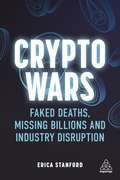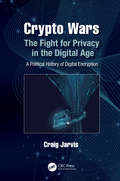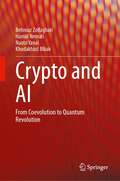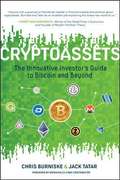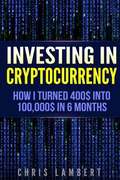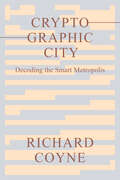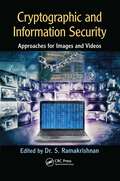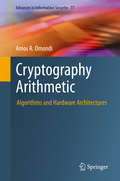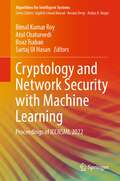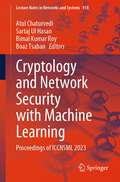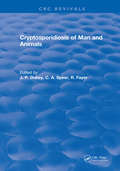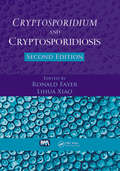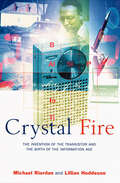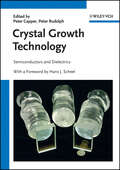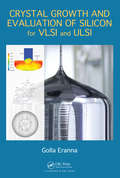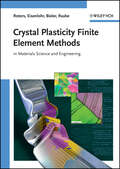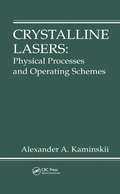- Table View
- List View
Crypto Wars: Faked Deaths, Missing Billions and Industry Disruption
by Erica StanfordCrypto is big news. You may be an existing user yourself or have friends that laud its promise of getting rich fast. Arm yourself with knowledge to come out on top in the crypto wars. If thousands of people can lose billions of dollars in OneCoin, masterminded by the now infamous Missing Cryptoqueen made famous by the BBC's podcast series and called 'one of the biggest scams in history' by The Times, what makes you think your money is safe? OneCoin isn't alone. Crypto Wars reveals some of the most shocking scams affected millions of innocent people all around the world with everything from religious leaders to celebrities involved. In this book, you get exclusive access to the back story of the most extreme Ponzi schemes, the most bizarre hoaxes and brutal exit strategies from some of the biggest charlatans of crypto.Crypto expert and educator, Erica Stanford, will show you how market-wide manipulation schemes, unregulated processes and a new collection of technologies that are often misunderstood, have been exploited to create the wild west of crypto, run by some less than reputable characters. From OneCoin to PonziCoin to Trumpcoin and everything in between, Crypto Wars uncovers the scandals, unpicks the system behind them and allows you to better understand a new technology that has the potential to revolutionize banking and our world for the better.
Crypto Wars: The Fight for Privacy in the Digital Age: A Political History of Digital Encryption
by Craig JarvisThe crypto wars have raged for half a century. In the 1970s, digital privacy activists prophesied the emergence of an Orwellian State, made possible by computer-mediated mass surveillance. The antidote: digital encryption. The U.S. government warned encryption would not only prevent surveillance of law-abiding citizens, but of criminals, terrorists, and foreign spies, ushering in a rival dystopian future. Both parties fought to defend the citizenry from what they believed the most perilous threats. The government tried to control encryption to preserve its surveillance capabilities; privacy activists armed citizens with cryptographic tools and challenged encryption regulations in the courts. No clear victor has emerged from the crypto wars. Governments have failed to forge a framework to govern the, at times conflicting, civil liberties of privacy and security in the digital age—an age when such liberties have an outsized influence on the citizen–State power balance. Solving this problem is more urgent than ever. Digital privacy will be one of the most important factors in how we architect twenty-first century societies—its management is paramount to our stewardship of democracy for future generations. We must elevate the quality of debate on cryptography, on how we govern security and privacy in our technology-infused world. Failure to end the crypto wars will result in societies sleepwalking into a future where the citizen–State power balance is determined by a twentieth-century status quo unfit for this century, endangering both our privacy and security. This book provides a history of the crypto wars, with the hope its chronicling sets a foundation for peace.
Crypto and AI: From Coevolution to Quantum Revolution
by Khodakhast Bibak Behrouz Zolfaghari Hamid Nemati Naoto YanaiThis book studies the intersection between cryptography and AI, highlighting the significant cross-impact and potential between the two technologies. The authors first study the individual ecosystems of cryptography and AI to show the omnipresence of each technology in the ecosystem of the other one. Next, they show how these technologies have come together in collaborative or adversarial ways. In the next section, the authors highlight the coevolution being formed between cryptography and AI. Throughout the book, the authors use evidence from state-of-the-art research to look ahead at the future of the crypto-AI dichotomy. The authors explain how they anticipate that quantum computing will join the dichotomy in near future, augmenting it to a trichotomy. They verify this through two case studies highlighting another scenario wherein crypto, AI and quantum converge. The authors study current trends in chaotic image encryption as well as information-theoretic cryptography and show how these trends lean towards quantum-inspired artificial intelligence (QiAI). After concluding the discussions, the authors suggest future research for interested researchers.
Cryptoassets: The Innovative Investor's Guide to Bitcoin and Beyond
by Chris Burniske Jack TatarThe innovative investor’s guide to an entirely new asset class from Chris Burniske and Jack Tatar. <P><P>With the rise of bitcoin and blockchain technology, investors can capitalize on the greatest investment opportunity since the Internet. Bitcoin was the first cryptoasset, but today there are over 800 and counting, including ether, ripple, litecoin, monero, and more. <P><P>This clear, concise, and accessible guide from two industry insiders shows you how to navigate this brave new blockchain world’and how to invest in these emerging assets to secure your financial future.
Cryptocurrencies and the Blockchain Revolution: Bitcoin and Beyond
by Brendan JanuaryIn January 2009, a mysterious software developer, Satoshi Nakamoto, exchanged a specially designed code with another developer. The code was a digital currency that Nakamoto had proposed several months before in a paper titled “Bitcoin: A Peer-to-Peer Electronic Cash System.” This was the first Bitcoin transaction. Since then, Bitcoin has become the face of a tech revolution in digital cryptocurrencies based on blockchain technology. Its success has sparked a tech revolution that could fundamentally change global economics. Author Brendan January delves into the world of coders, libertarians, criminals, financial regulators, and crypto-detectives to understand what digital cryptocurrencies have to offer, their limitations and potential pitfalls, security issues, and how they may affect government and financial regulations in the future.
Cryptocurrency: How I Turned $400 Into $100,000 By Trading Cryprocurrency In 6 Months
by Chris Lambert<p>In this book I want to introduce you to the incredible opportunities cryptocurrencies are bringing into our markets today and, more importantly, how you can take advantage of them to multiply your investments. In the first chapters I will provide you with a fundamental understanding of cryptocurrencies and the current state Blockchain technology. <p>After covering fundamental background knowledge, we will dive into real hands-on experience. I will show you how to purchase cryptocurrencies using today's most effective online Exchange platforms and how to store them securely and safely using an eWallet. Finally, in the last section of the book I will discuss the future of the market. In this section I will show you how to evaluate the potential of a new cryptocurrency and what investment strategies you can employ to achieve the highest returns. <p>Please understand this book will not make you an expert trader in cryptocurrencies. I challenge any single book to make this claim - today's cryptocurrency market is a new and extremely complicated space that is constantly evolving and reshaping in unexpected ways. There are still many unexplored paths and a vast amount of concepts to prove.</p>
Cryptographic City: Decoding the Smart Metropolis
by Richard CoyneCryptography&’s essential role in the functioning of the city, viewed against the backdrop of modern digital life.Cryptography is not new to the city; in fact, it is essential to its functioning. For as long as cities have existed, communications have circulated, often in full sight, but with their messages hidden. In Cryptographic City, Richard Coyne explains how cryptography runs deep within the structure of the city. He shows the extent to which cities are built on secrets, their foundations now reinforced by digital encryption and cryptocurrency platforms. He also uses cryptography as a lens through which to inspect smart cities and what they deliver. Coyne sets his investigation into the cryptographic city against the backdrop of the technologies, claims, and challenges of the smart city.Cryptography provides the means by which communications within and between citizens and devices are kept secure. Coyne shows how all of the smart city innovations—from smart toasters to public transportation networks—are enabled by secure financial transactions, data flows, media streaming, and communications made possible by encryption. Without encryption, he says, communications between people and digital devices would be exposed for anyone to see, hack, and misdirect. He explains the relevant technicalities of cryptography and describes the practical difference it makes to frame cities as cryptographic. Interwoven throughout the book are autobiographical anecdotes, insights from Coyne&’s teaching practice, and historical reports, making it accessible to the general reader.
Cryptographic Engineering
by Cetin Kaya KocThis book is for engineers and researchers working in the embedded hardware industry. This book addresses the design aspects of cryptographic hardware and embedded software. The authors provide tutorial-type material for professional engineers and computer information specialists.
Cryptographic and Information Security Approaches for Images and Videos: Approaches For Images And Videos
by S. RamakrishnanThis book presents essential principles, technical information, and expert insights on multimedia security technology. Illustrating the need for improved content security as the Internet and digital multimedia applications rapidly evolve, it presents a wealth of everyday protection application examples in fields including . Giving readers an in-depth introduction to different aspects of information security mechanisms and methods, it also serves as an instructional tool on the fundamental theoretical framework required for the development of advanced techniques.
Cryptography Arithmetic: Algorithms and Hardware Architectures (Advances in Information Security #77)
by Amos R. OmondiModern cryptosystems, used in numerous applications that require secrecy or privacy - electronic mail, financial transactions, medical-record keeping, government affairs, social media etc. - are based on sophisticated mathematics and algorithms that in implementation involve much computer arithmetic. And for speed it is necessary that the arithmetic be realized at the hardware (chip) level. This book is an introduction to the implementation of cryptosystems at that level.The aforementioned arithmetic is mostly the arithmetic of finite fields, and the book is essentially one on the arithmetic of prime fields and binary fields in the context of cryptography. The book has three main parts. The first part is on generic algorithms and hardware architectures for the basic arithmetic operations: addition, subtraction, multiplication, and division. The second part is on the arithmetic of prime fields. And the third part is on the arithmetic of binary fields. The mathematical fundamentals necessary for the latter two parts are included, as are descriptions of various types of cryptosystems, to provide appropriate context.This book is intended for advanced-level students in Computer Science, Computer Engineering, and Electrical and Electronic Engineering. Practitioners too will find it useful, as will those with a general interest in "hard" applications of mathematics.
Cryptography and Embedded Systems Security
by Jakub Breier Xiaolu HouThis textbook provides an all-in-one approach for learning about hardware security of cryptographic systems. It gives the necessary background on mathematics that is used for the construction of symmetric and public-key cryptosystems. Then, it introduces the most commonly used encryption algorithms that can be found on a wide variety of embedded devices to provide confidentiality, integrity, and authenticity of the messages/data. Finally, it provides theoretical and practical details on the two most common attack methods in hardware security – side-channel attacks, and fault injection attacks, together with the protection methods used against both.
Cryptology and Network Security with Machine Learning: Proceedings of ICCNSML 2022 (Algorithms for Intelligent Systems)
by Bimal Kumar Roy Atul Chaturvedi Boaz Tsaban Sartaj Ul HasanThe book features original papers from International Conference on Cryptology & Network Security with Machine Learning (ICCNSML 2022), organized by PSIT, Kanpur, India during 16 – 18 December 2022. This conference proceeding will provide the understanding of core concepts of Cryptology & Network Security with ML in data communication. The book covers research papers in public key cryptography, elliptic curve cryptography, post quantum cryptography, lattice based cryptography, non-commutative ring based cryptography, cryptocurrency, authentication, key agreement, Hash functions, block/stream ciphers, polynomial based cryptography, code based cryptography, NTRU cryptosystems, security and privacy in machine learning, block chain, IoT security, wireless security protocols, cryptanalysis, number theory, quantum computing, cryptographic aspects of network security, complexity theory, and cryptography with machine learning.
Cryptology and Network Security with Machine Learning: Proceedings of ICCNSML 2023 (Lecture Notes in Networks and Systems #918)
by Bimal Kumar Roy Atul Chaturvedi Boaz Tsaban Sartaj Ul HasanThe book features original papers from International Conference on Cryptology & Network Security with Machine Learning (ICCNSML 2023), organized by PSIT, Kanpur, India during 27–29 October 2023. This conference proceeding provides the understanding of core concepts of Cryptology and Network Security with ML in data communication. The book covers research papers in public key cryptography, elliptic curve cryptography, post-quantum cryptography, lattice based cryptography, non-commutative ring-based cryptography, cryptocurrency, authentication, key agreement, Hash functions, block/stream ciphers, polynomial-based cryptography, code-based cryptography, NTRU cryptosystems, security and privacy in machine learning, blockchain, IoT security, wireless security protocols, cryptanalysis, number theory, quantum computing, cryptographic aspects of network security, complexity theory, and cryptography with machine learning.
Cryptonomicon
by Neal StephensonWith this extraordinary first volume in what promises to be an epoch-making masterpiece, Neal Stephenson hacks into the secret histories of nations and the private obsessions of men, decrypting with dazzling virtuosity the forces that shaped this century. As an added bonus, the e-book edition of this New York Times bestseller includes an excerpt from Stephenson's new novel, Seveneves.In 1942, Lawrence Pritchard Waterhouse—mathematical genius and young Captain in the U.S. Navy—is assigned to detachment 2702. It is an outfit so secret that only a handful of people know it exists, and some of those people have names like Churchill and Roosevelt. The mission of Waterhouse and Detachment 2702—commanded by Marine Raider Bobby Shaftoe-is to keep the Nazis ignorant of the fact that Allied Intelligence has cracked the enemy's fabled Enigma code. It is a game, a cryptographic chess match between Waterhouse and his German counterpart, translated into action by the gung-ho Shaftoe and his forces.Fast-forward to the present, where Waterhouse's crypto-hacker grandson, Randy, is attempting to create a "data haven" in Southeast Asia—a place where encrypted data can be stored and exchanged free of repression and scrutiny. As governments and multinationals attack the endeavor, Randy joins forces with Shaftoe's tough-as-nails granddaughter, Amy, to secretly salvage a sunken Nazi submarine that holds the key to keeping the dream of a data haven afloat. But soon their scheme brings to light a massive conspiracy with its roots in Detachment 2702 linked to an unbreakable Nazi code called Arethusa. And it will represent the path to unimaginable riches and a future of personal and digital liberty...or to universal totalitarianism reborn.A breathtaking tour de force, and Neal Stephenson's most accomplished and affecting work to date, Cryptonomicon is profound and prophetic, hypnotic and hyper-driven, as it leaps forward and back between World War II and the World Wide Web, hinting all the while at a dark day-after-tomorrow. It is a work of great art, thought and creative daring; the product of a truly iconoclastic imagination working with white-hot intensity.
Cryptosporidiosis of Man and Animals
by J. P. DubeyThis book attempts to provide a broad coverage of current information needed by public health workers, physicians, veterinarians, parasitologists, technicians, and various biologists who encounter or work with the parasitic disease Cryptosporidium.
Cryptosporidium and Cryptosporidiosis
by Lihua Xiao Ronald FayerFrom the microscopic observation of infection to the widespread application of molecular techniques in taxonomy and epidemiology, to the genome sequencing of two major species and advances in biochemistry, phylogeny, and water treatment, new information on this fascinating genus continues to mount as we discover and utilize the latest scientific te
Cryptosporidium as a Foodborne Pathogen (SpringerBriefs in Food, Health, and Nutrition)
by Lucy J. RobertsonAlthough widely recognized as an important waterborne pathogen, Cryptosporidium spp. can also be transmitted by contamination of food. The same properties of this protozoan parasite that mean that water is an excellent transmission vehicle are also important for foodborne transmission. These include the low infective dose, the high number of oocysts that are excreted, and the robustness of these transmission stages. However, many more outbreaks of waterborne cryptosporidiosis have been reported than foodborne outbreaks. This is probably partly due to epidemiological tracing being much more difficult for foodborne outbreaks than waterborne outbreaks, and the number of persons exposed to infection often being fewer. Nevertheless, the potential importance of foodborne transmission is gradually being recognized, and a wide range of different foodstuffs have been associated with those outbreaks that have been recorded. Additionally, various factors mean that the potential for foodborne transmission is becoming of increasing importance: these include the growth of international food trade, a current trend for eating raw or very lightly cooked foods, and the rise in small-scale organic farms, where there the possibility for contamination of vegetable crops with animal feces may be greater.
Crystal Fire: The Invention Of The Transistor And The Birth Of The Information Age
by Michael Riordan Lillian Hoddeson"Without the invention of the transistor, I'm quite sure that the PC would not exist as we know it today."—Bill Gates On December 16, 1947, John Bardeen and Walter Brattain, physicists at Bell Laboratories, jabbed two electrodes into a sliver of germanium. The power flowing from the germanium far exceeded what went in; in that moment the transistor was invented and the Information Age was born. No other devices have been as crucial to modern life as the transistor and the microchip it spawned, but the story of the science and personalities that made these inventions possible has not been fully told until now. Crystal Fire fills this gap and carries the story forward. William Shockley, Bell Labs' team leader and co-recipient of the Nobel Prize with Brattain and Bardeen for the discovery, grew obsessed with the transistor and went on to become the father of Silicon Valley. Here is a deeply human story about the process of invention — including the competition and economic aspirations involved — all part of the greatest technological explosion in history. The intriguing history of the transistor — its inventors, physics, and stunning impact on society and the economy — unfolds here in a richly told tale."—Science News "Thoroughly accessible to lay readers as well as the techno-savvy. . . . [A] fine book."—Publishers Weekly
Crystal Growth Technology
by Peter Capper Hans J. Scheel Peter RudolphSemiconductors and dielectrics are two essential materials found in cell phones and computers, for example, and both are manufactured by growing crystals.Edited by the organizers of the International Workshop on Crystal Growth Technology, this ready reference is essential reading for materials scientists, chemists, physicists, computer hardware manufacturers, engineers, and those working in the chemical and semiconductor industries. They have assembled an international team of experts who present the current challenges, latest methods and new applications for producing these materials necessary for the electronics industry using bulk crystal growth technology.From the contents:* General aspects of crystal growth technology* Compound semiconductors* Halides and oxides* Crystal growth for sustaining energy* Crystal machining
Crystal Growth and Evaluation of Silicon for VLSI and ULSI
by Golla ErannaSilicon, as a single-crystal semiconductor, has sparked a revolution in the field of electronics and touched nearly every field of science and technology. Though available abundantly as silica and in various other forms in nature, silicon is difficult to separate from its chemical compounds because of its reactivity. As a solid, silicon is chemical
Crystal Plasticity Finite Element Methods
by Philip Eisenlohr Dierk Raabe Thomas R. Bieler Franz RotersWritten by the leading experts in computational materials science, this handy reference concisely reviews the most important aspects of plasticity modeling: constitutive laws, phase transformations, texture methods, continuum approaches and damage mechanisms. As a result, it provides the knowledge needed to avoid failures in critical systems udner mechanical load. With its various application examples to micro- and macrostructure mechanics, this is an invaluable resource for mechanical engineers as well as for researchers wanting to improve on this method and extend its outreach.
Crystal Structure,Electronic and Optical Properties of Epitaxial Alkaline Earth Niobate Thin Films (Springer Theses)
by Dongyang WanThis impressive thesis offers a comprehensive scientific study of the alkaline earth niobates and describes their nonlinear optical properties for the first time. It explores the crystal structure, electrical properties, optical absorption properties, hot carrier dynamics, nonlinear optical property and strain-induced metal to insulator transition of alkaline earth niobates using advanced experimental techniques. These alkaline earth niobates can have a strong plasmon resonance in the visible range due to their large carrier density, and this unique property gives rise to the emergent phenomenon of photocatalysis and nonlinear optical properties. This series of intrinsic plasmonic materials based on niobates, can be used as a photocatalyst to split water under sunlight, a novel saturable absorber in the high-power ultrashort pulsed laser system, and as a sensor in microelectromechanical systems.
Crystalline Lasers: Physical Processes and Operating Schemes
by Alexander KaminskiiBy the end of the 1970s, crystalline lasers were widely used in science, engineering, medicine, and technology. The types of lasers used have continued to grow in number to include newly discovered crystalline hosts, previously known compounds generating at other spectral wavelengths, and broadband tunable stimulated emission. This has led to the creation of an extremely promising new generation of crystalline lasers that are both highly efficient and more reliable. The major part of this book is devoted to describing multilevel operating laser schemes for stimulated emission excitation in insulating crystals doped with lanthanide ions.The first part of Crystalline Lasers deals with the history of the physics and spectroscopy of insulating laser crystals. The chapters in the second part of the book present results from the study of Stark-energy levels of generating ions in laser crystals and their radiative and nonradiative intermanifold transition characteristics. This section includes extensive tabular data and reference information. Popular and novel operating schemes of crystalline lasers are covered in Part 3.In the chapters in the fourth part of the book, the newest technologies in the physics and engineering of crystalline lasers are considered. The results of investigations into laser action under selective excitations, miniature crystalline lasers, and the properties of nonlinear activated laser crystals are presented and analyzed.Crystalline Lasers summarizes and reviews the results of many years of research and studies of activator ions and multilevel operating laser schemes, and discusses exciting prospects of using these systems to create new types of crystalline lasers. This book will be of use to laser scientists and engineers, physicists, and chemical engineers.
Crystalline Metal Oxide Catalysts
by Wataru UedaThis book introduces the innovatively advanced crystalline metal oxide catalysts that have multi-catalytic functions on the basis of spatially placed elements in crystal structure. With authors who are experts in their fields, the chapters of the book are organized according to catalytic function, on the basis of crystal structure. The book also covers the structure determination of micro–nano-sized metal oxide crystals that are now standard in most catalytic materials and new trends in catalyst development using materials informatics and catalytic informatics. The information contained here will guide researchers who are eager to carry out sustainable catalytic processes and ultimately to achieve a sustainable society in their quest for catalyst development.
Crystalline Silicon Solar Cells: Carbon to Silicon — A Paradigm Shift in Electricity Generation, Volume 1
by Saleem Hussain ZaidiThis book focuses on crystalline silicon solar cell science and technology. It is written from the perspective of an experimentalist with extensive hands-on experience in modeling, fabrication, and characterization. A practical approach to solar cell fabrication is presented in terms of its three components: materials, electrical, and optical. The materials section describes wafer processing methods including saw damage removal, texturing, diffusion, and surface passivation. The electrical section focuses on formation of ohmic contacts on n and p-doped surfaces. The optical section illustrates light interaction with textured silicon surfaces in terms of geometrical, diffractive and physical optics, transmission, and surface photovoltage (SPV) spectroscopy. A final chapter analyzes performance of solar cells, fabricated with a wide range of process parameters. A brief economic analysis on the merits of crystalline silicon-based photovoltaic technology as a cottage industry is also included.This professional reference will be an important resource for practicing engineers and technicians working with solar cell and PV manufacturing and renewable energy technologies, as well as upper-level engineering and material science students.Presents a practical approach to solar cell fabrication, and characterization;Offers modular methodology with detailed equipment and process parameters supported by experimental results;Includes processing diagrams and tables for 16% efficient solar cell fabrication.
